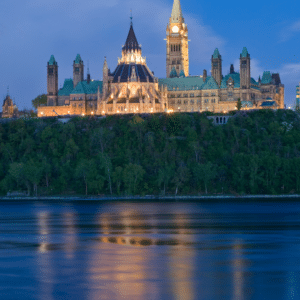A million tons of radioactive waste next to the Ottawa River? You Must Be Kidding
By Ole Hendrickson, Chair of Board of the Sierra Club Canada Foundation
 The Sierra Club Canada Foundation is condemning a Government of Canada decision to allow 80 years’ worth of its accumulated radioactive waste to be put in a gigantic landfill surrounded by wetlands that drain into the Ottawa River, 1 kilometer away.
The Sierra Club Canada Foundation is condemning a Government of Canada decision to allow 80 years’ worth of its accumulated radioactive waste to be put in a gigantic landfill surrounded by wetlands that drain into the Ottawa River, 1 kilometer away.
Partially treated leachate from the landfill would be discharged either into the wetlands or directly into Perch Lake, a 45 hectare water body that feeds into the Ottawa River on the edge of the Canadian Shield.
After a nearly 8-year-long assessment under the 2012 version of the Canadian Environmental Act, Rumina Velshi, ex-president of the Canadian Nuclear Safety Commission (CNSC), signed off on the so-called “Near Surface Disposal Facility” (NSDF) project on January 9, 2024. Ms. Velshi recently attracted media attention for having spent nearly $100k more on travel than the next closest senior bureaucrat over a 19-month period.
Her signature means that a private consortium contracted by the Harper government in 2015, now made up of two US-based multinationals and AtkinsRealis (formerly SNC-Lavalin), can proceed with construction of Canada’s first-ever permanent disposal facility for nuclear reactor waste, for the convenience of the industry and the benefit of its shareholders.
Under a 10-year federal contract worth more than $10 billion, the consortium was given ownership of a former Atomic Energy of Canada Limited (AECL) subsidiary called Canadian Nuclear Laboratories (CNL). Under a “Site Operating Company” agreement, CNL must reduce the $8 billion federal nuclear liability as quickly and cheaply as possible. The agreement called for an operating waste facility by 2021, which CNL failed to meet owing to significant opposition from First Nations, citizens’ groups, NGOs, and downstream municipalities. CNL’s owners want shovels in the ground before their contract expires in September 2025.
Wastes proposed for the giant landfill are currently stored in 20-foot intermodal containers, 50-gallon drums, and steel waste boxes. They include radioactively contaminated piping, concrete, asbestos, bricks, and lumber from demolition of old structures; and soils contaminated by past dumping of radionuclides mixed with toxic organic chemicals (including PCBs and dioxins) and heavy metals (cadmium, lead, mercury, etc.) in unlined sand trenches. Industrial wastes shipped to Chalk River from companies across Canada would also go in the landfill.
Large amounts of waste were generated by reactor accidents at Chalk River in 1952 and 1958. Facilities used to extract plutonium for nuclear weapons also suffered accidents. These wastes will remain hazardous for thousands to millions of years.
The NSDF’s proximity to the Ottawa River would ensure that detectable quantities of long-lived, man-made radioactive substances and other toxic wastes will pollute the river in perpetuity. The location was chosen to minimize costs of hauling waste from the dozens of radioactively contaminated structures in the “Active Area” at Chalk River.
Ten Algonquin First Nations, on whose unceded land the facility would be built, have registered their objections in the strongest possible terms. They note that section 29(2) of the UN Declaration of the Rights of Indigenous Peoples requires the Government of Canada to obtain their free, prior, and informed consent before disposing of hazardous waste in their territory.
To build the NSDF, CNL would destroy 35 hectares of near old-growth forest adjacent to the Perch Lake wetlands. The forest, unlogged for 80 years, is home to bear dens, a wolf pack, beaver, moose, and turtles. CNL would then blast out the side of a small mountain and install a “plastic geomembrane” it says could contain waste for centuries.
Few Canadians have heard of the NSDF, owing to the heavy veil of secrecy that the Government of Canada maintains over its nuclear installations. It allows unelected CNSC commissioners to make controversial decisions involving nuclear energy, which Parliament declared to be an undertaking “for the general advantage of Canada” under the 1997 Nuclear Safety and Control Act, which has never since been reviewed.
However, the government cannot wholly escape responsibility for the NSDF. According to the CNSC decision, it must issue a permit for destruction of habitat for at-risk species, including migratory birds, bats, turtles, black ash, and threatened Eastern Wolves. This inherently brings the government’s role into question.
Critics of the decision say that it reinforces a widely held belief that Canada’s nuclear governance system is broken and the CNSC is captured by the nuclear industry.
Sierra Club Canada and other NGOs are calling on the federal government to fix Canada’s broken nuclear governance regime, take responsibility for its radioactive waste, stop hiding behind the multinational consortium that is pushing this ill-conceived plan, and protect the drinking water of millions of Canadians in municipalities downstream from the proposed landfill.
